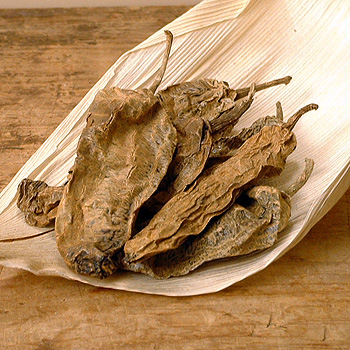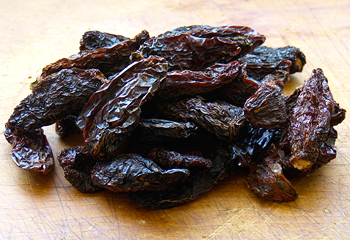 Chipotle Chiles (Tipico type)
Chipotle Chiles (Tipico type)© Denzil Green
Chipotles are jalapenos that have been allowed to ripen from green to red, and then are dried and smoked. At this point, they become a dark tan colour. The drying removes 80 to 90 percent of the moisture in that chile and that, along with the smoke, preserves it by retarding the growth of bacteria.
In Mexico, one way of smoking small batches is to have one pit with a fire going in it. You arrange the red jalapenos on a rack, and place the rack in a second pit nearby connected to the fire pit via an underground tunnel. The smoke from the fire pit gets drawn though the tunnel and into the second pit and up and over the peppers. In America, enthusiasts like to smoke their own chipotles with backyard smokers or barbeques, with varying success.
Chile Heat: 2,500 – 8,000 Scoville Units (same as for jalapenos.)
You can buy chipotles dried or canned.
Dried Chipotles
If your dried chipotles are broken, that may be a sign that they are so old they are brittle. Choose ones which are still a bit supple. You first need to soak dried chipotles in hot water for an hour, then mash them and strain.
Canned Chipotles
Canned chipotles are usually dried chipotles which have already been reconstituted and are ready to go. They are usually canned in a thick adobo sauce, which is vinegar, herbs and ground chilies.
Chipotle Powder
To make a chile powder out of dried chipotles, dry them out further in a dehydrator or even at a low temperature until they become brittle. (See hot pepper drying directions on our food preservation site.) Then grind in blender, spice mill or food processor. Store in sealed container either at room temperature or freeze.
Chipotle Oil
To make chipotle oil, grind a few dried chipotles in a blender or food processor (you want to make them finely chopped, not into a powder.) Simmer gently in a cup or two of oil for a few minutes. Let stand for at least a few hours before using. Refrigerate leftover oil for probably up to a month. Use to brush on meats and fish for barbequing.
Types of Chipotle
There are actually a few varieties of chipotles, varying in how they are processed. The two main are Morita and Típico.
Chipotle Chiles (Morita type)
© Denzil Green
Morita Chipotles
Moritas chipotles are not smoked as long as Típicos are, so the smoky flavour is less intense and the colour stays a dark red, sometimes purple.
Morita chipotles are available in Mexico and America.
Morita means “little blackberry” in Spanish.
Típico Chipotles
Típico chipotles are smoked longer than Moritas. They consequently have a more intense flavour and a tan colour.
Most of the ones produced are consumed in Mexico; the demand there leaves few for export. Many less than honest producers flog Moritas to North American markets as Típicos, pocketing the higher price they can charge, and gambling that the “gringos” won’t know the difference.
Típico chipotles are available in Mexico and America.
Cooking Tips
You can use canned and dried chipotles interchangeably (though obviously you have to soak the dried first, the canned are ready to go, and obviously you can’t make a chile powder from the canned.)
To use the dried, toast them in a skillet first for a few minutes to wake up the flavour, then soak in hot water for about 30 minutes. You can use the water in what you are making, or freeze for another dish. Remove the chiles from the water, and then finely chop or purée into a paste, and use in your recipe. No need to remove the seeds.
To use canned chipotles, use them straight from the tin, either whole or chopped. You can also purée them in some of their sauce. Roughly chop them before putting in the blender. No need to remove the seeds. For ideas on what to do with any leftover sauce from the can, see entry for adobo sauce.
The same precautions with handling chiles (see entry on chile peppers) apply to chipotles.
Substitutes
Liquid smoke, plus Jalapenos.
Equivalents
10 (4.5 kg) pounds fresh, ripened jalapenos = 1 pound (450 g) dried chipotles;
1 x 12 oz (350 ml) can generally contains about 30 chipotles
Storage Hints
Store dried chipotles in a sealed jar or sealed plastic bag in a dry, cool place for up to two years. Or, freeze them in freezer bags for several years.
To refrigerate leftover canned chipotles, transfer them including the sauce to a container with a lid, and refrigerate for up to a few weeks. Just make sure the sauce covers them; add a bit of vinegar if needed to do this. To freeze them, spread them out on a plate, freeze, and then gather them into a freezer bag. Freeze the sauce separately.
History Notes
Natives in South America had found that while most chiles would dry well in the sun, certain types which had thicker, fleshier walls (such as Jalapenos) wouldn’t — they would just rot first before drying. Centuries before the Aztecs even came along, natives living in Teotihuacan, north of what is now Mexico City, discovered that they could dry these chiles as they did meat, with smoke.
Language Notes
The Aztecs inherited the smoking and drying technique, and called the peppers “chilpotle”. “Chil” was the chile; “poctli” meant smoked. Though “chipotle” means just “smoked pepper”, it is in practice applied to smoked jalapeno chile peppers. It is pronounced “chee — POHTE — lay”.
Do not confuse with “chipotlas”, which are sausages.


